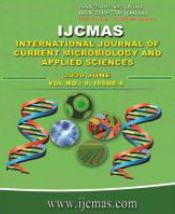


 National Academy of Agricultural Sciences (NAAS)
National Academy of Agricultural Sciences (NAAS)

|
PRINT ISSN : 2319-7692
Online ISSN : 2319-7706 Issues : 12 per year Publisher : Excellent Publishers Email : editorijcmas@gmail.com / submit@ijcmas.com Editor-in-chief: Dr.M.Prakash Index Copernicus ICV 2018: 95.39 NAAS RATING 2020: 5.38 |
Cluster frontline demonstration (CFLDs) is one of the key extension tools for transfer of technology at grass root level that directly impact the horizontal spread of technology. Pulses play an important role in the food and farming economy of our country. Considering their limited input requirements, soil enriching properties and suitability for growing in areas where moisture (water) is limited, pulses occupy a unique place in our agriculture system. The area, production and productivity of pulses of Uttar Pradesh and in district Gorakhpur is also quite low as compare to other states, national acreage and production. Among various constraints, poor crop management and protection technologies assume primary position for considering the facts of low yield of pulse crops. Under centrally sponsored scheme on pulses production technology under NFSM scheme, the Mahayogi Gorakhnath Krishi Vigyan Kendra, Gorakhpur conducted 175 and 35 demonstrations on pigeon pea and chickpea during 2017-18 and 2018-19 respectively. The critical inputs were identified in existing production technology through farmers meetings and group discussion. The findings in respect of pigeon pea and chickpea overall yield trend of demonstrations ranged from 12.77 to 17.32 q/ha and 17.56 to 19.23 q/ha and yield increase ranged from 36.70 to 42.55 per cent and 42.67 to 57.91 per cent over the local practices yield, respectively. The yield levels were considerably lower under local practices because of considerable variation in the extent of adoption of recommended technology depending upon the amount of risk involved in terms of cost, convenience, skill and knowledge about the concerned practice. Average extension gap, technology gap and technology index of pigeon pea and chickpea were found 4.07, 10.66 q/ha and 42.64 per cent and 5.87, 6.45 q/ha and 26.85 per cent, respectively. Average gross returns and net returns of demonstration in pigeon pea and chickpea crops were 39.63 and 57.42 per cent and 56.57 and 88.28 per cent higher than the farmers’ practices respectively. Average benefit cost ratio was found higher throughout the study in pigeon pea and chickpea i.e. 3.47 and 3.27 respectively. The overall adoption level of pigeon pea and chickpea production technology were increased by 211.46 and 285.76 per cent respectively, due to CFLDs. The varieties of pigeon pea such as NA 1 and local (old and mix variety) were replaced by NA 2 and local old mixed variety of chickpea was replaced by GNG 1581 in cluster demonstration. In present study efforts were also made to study the impact of CFLDs on horizontal spread of variety of different pulse crops viz. pigeon pea and chickpea which was increased 462.50% and 366.67%, respectively, if appropriate package and practices are followed.
 |
 |
 |
 |
 |